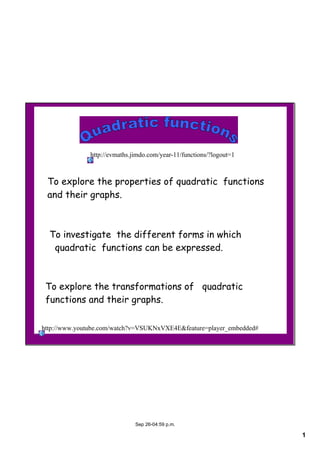Quadratics 1
- 1. 1 Sep 26Â04:59 p.m. To explore the properties of quadratic functions and their graphs. To investigate the different forms in which quadratic functions can be expressed. To explore the transformations of quadratic functions and their graphs. http://www.youtube.com/watch?v=VSUKNxVXE4E&feature=player_embedded# http://evmaths.jimdo.com/yearÂ11/functions/?logout=1
- 5. 5 Sep 26Â04:59 p.m. Conclusions: y = a x 2 The graph of is a parabola with vertex: (0,0) line of symmetry :   x = 0 a > 0 a < 0 |a | > 1 as "a" increases the parabola gets "thinner" 0 < |a| <1 the parabola looks "fatter" "a " produces a stretch along the y-axis
- 6. 6 Sep 26Â04:59 p.m. Sketch the graphs of  and vertex: line of symmetry: vertex: line of symmetry: y = ( x + 3)2 y = ( x Â 2 )2 y = x2
- 7. 7 Sep 26Â04:59 p.m. Conclusions: parabola moves to the right parabola moves to the left vertex: line of symmetry: vertex: line of symmetry: ( h  , 0  ) x = h ( Â h  , 0  ) x = Â h Translation along xÂaxis ( h > 0 )
- 8. 8 Sep 26Â04:59 p.m. Sketch the graphs of and y=x2 y=x2  Â2 y=x2  +3 vertex: line of symmetry: vertex: line of symmetry:
- 9. 9 Sep 26Â04:59 p.m. Conclusions: parabola moves upwards parabola moves downwards vertex: line of symmetry: ( 0 , k  ) x = 0 Translation  k units along yÂaxis k > 0 k < 0
- 10. 10 Sep 26Â04:59 p.m. Conclusions: vertex (h , k) (Âh , k) In general: represents a parabola âĒ with vertex in (h,k) âĒ axis of symmetry x = h âĒ a produces a stretch parallel to the y- axis âĒ a > 0 âĒ a < 0
- 11. 11 Sep 26Â04:59 p.m. y = ( x Â 1 ) 2  + 3 vertex: line of symmetry: y = 2 ( x Â 3 ) 2   vertex: line of symmetry: (1,3) x=1 (3,0) x=3
- 12. 12 Sep 26Â04:59 p.m. y = Â 3 x2  + 4   vertex: line of symmetry: y = 3 ( x + 1 ) 2  Â 2 vertex: line of symmetry: (0,4) x=0 (-1,-2) x=-1 http://members.shaw.ca/ron.blond/QFA.CSF.APPLET/index.html Transformaciones FunciÃģn CuadrÃĄtica.ggb
- 13. 13 Sep 26Â04:59 p.m. For Parabolas of the form What is the yÂintercept ? Find the roots of f. Concavity? factorising (if possible) by formula (y = 0)
- 15. 15 Sep 26Â04:59 p.m. Line of symmetry is in the middle between the roots : The vertex will be on the line of symmetry: We can also find the line of symmetry by doing : y - intercept: ( 0 , c ) a < 0a >0 Cambios cuadratica.ggb
- 16. 16 Sep 26Â04:59 p.m.  For find: y- intercept: line of symmetry: vertex: roots: Now draw a sketch of the function.
- 17. 17 Sep 26Â04:59 p.m.  y- intercept: line of symmetry: vertex: roots: Now draw a sketch of the function. Express f(x) in the form  Â
- 18. 18 Sep 26Â04:59 p.m. y = a (x Â x1) ( x Â x2)Parabolas of the form : y = ( x Â 3 ) ( x + 1 ) Roots: Line of symmetry: Vertex: In general: x1  and   x2




















